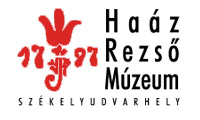Kovács Petronella (szerk.): Isis - Erdélyi magyar restaurátor füzetek 10. (Székelyudvarhely, 2010)
B. Perjés Judit - Domokos Levente - Puskás Katalin: Tíz nap a "Nagy-Küküllő felső folyása mentén" avagy hazi és vendég restaurátorok a székelykeresztúri Molnár István Múzeum születő állandó kiállításán
embody the Holy Trinity, appear behind her sharing red mantle. They hold various symbolic objects in the hands: a globe, a crown and a sceptre. Six infant angels dressed in yellow hold together the composition in the font. The background is decorated with a golden leaf ornament. It is not accidental that the technical literature describes it as a matchless work of art since according to art historical investigations, it has only a few or no analogues in the region. It is certainly a piece of art the master of which learned not in this region. According to the stylistic traits, the origin of the painting can be found in Salzburg: the rendering and the pictorial solutions of the details are certain evidences of the profound knowledge of masters of the Southern German territories (circles of Rueland Frueauf Sr and master Grossgmaini). The Szepesváralja altar in the National Gallery of Pozsony shows the greatest similarity with the pattern of the background. The style of this altar can also be attributed to the art of the abovementioned masters. The painter of the panel panting of Mary’s Crowning probably came from the same artistic environment as the Szepesváralja master: the style is generally of a Salzburg character coloured with many individual traits. The infrared radiation of the picture revealed sketches of the figures of the composition, which the painter applied over the gesso with narrower and wider sweeps of the brush. Smaller and larger discrepancies could be observed between the sketch and the final painting. The lines of the sketch nearly completely disappear at Mary’s face, since the pictorial formulation exactly follows the drawing. Only smaller, a couple of millimetres large discrepancies could be observed between the sketch and the painting at the three young men and the angels. The most conspicuous difference appeared in the case of Mary’s gesture: in the sketch the hands are raised to prayer, while in the painting they are clasped and turned down. The folds of the dress also changed: they run downs in loose arches until the angels kneeling in the foreground. After the investigations, the peeling paint layers were consolidated in the lower part of the panel painting. The dirt was wiped off from the surface with a soft brush, while the more persistent, greasy dirt was removed with the alternating application of chemical and mechanical methods. The solvent mixture chosen after cleaning tests (ethyl alcohol, dimethylsulphoxide, linseed oil and ammonium hydroxide) proved useful for wet cleaning. The clotted, greasy and resinous dirt layer on the lower part of the picture softened after repeated chemical treatment and it could be removed with an ophthalmologic scalpel. During cleaning, a thin coating was preserved on the surface of the entire painting. To seal the tiny missing areas of the paint layer, the mixture of 3.5-7% solution of isinglass glue and chalk was used, and the watercolour was applied for retouching mostly with trateggio technique. The replacement of the small wear did not necessary need tratteggio technique: it was the size of the missing area that determined the technique of completion. The large missing area of the paint layer in the lower part of the painting was not replaced similarly to the plastic injuries of the support because the missing areas do not disturb the compositional unity of the painting. Zsuzsanna Mara Painting conservator MA Muzeul Secuiesc al Ciucului Miercuirea Cuie Phone:+40-266-311-727 E-mail: zsuzsamara@yahoo.com Petronella Kovács Leather covered 18"' c. Transylvanian chests. Part 2 Condition survey and conservation possibilities The first part of the study published in the preceding volume of ISIS deals the manufacturing technique of the chests and the identification of the materials which were used to make them. The research comprised the classification of the chest according their motives, and the identification of the nationality of the former owners. This part describes the damages of the organic and the inorganic components of the examined chests. Then the possible treatments are outlined. Due to the desiccation of the wood, fissures, sometimes cracks appeared along the fittings of the chests. Damages caused by use are on the edges where the body of the chest and the lid meet. The leather covers dried out, crackled, tore and got detached from the wooden base. The leather darkened around the metal mounts, it became hard and shrunk on chests decorated with iron. Smaller and larger fragments are missing from the leather cover on each chest. On the fibres of 43 samples taken from the leather covers was carried out sizing test, measured the pH value, the iron content and the shrinkage temperature. The methods, the circumstances and the results of the investigations carried out on the leather samples are summarized in tables in the study. The low shrinkage temperatures call the attention to the fact that the leather covers are in a very poor condition. The applications prepared from iron got perforated at a few places in consequence of corrosion. Both the iron and the copper ornaments curled up, broke and became incomplete. In a few chests, the materials that cover the interior surfaces - textile, paper - are less exposed to environmental influences are relatively well preserved. In lucky cases, the structural composition and condition of objects prepared from various materials afford the separation of parts made from diverse materials and they can be treated separately. But the objects can only rarely be dismantled without causing physical injuries - a fact that is scarcely mentioned in conservation reports. In the case of the examined chests, the iron shafts of the corroded nails get stuck in the wood, sometimes the ends of the shafts were bent over the backsides of the planks, 187
